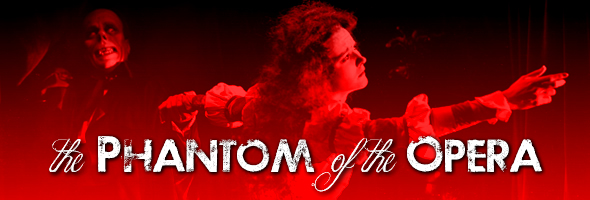
Color, 1925, 90/103m.
Directed by Rupert Julian
Starring Lon Chaney, Mary Philbin, Norman Kerry, Arthur Edmund Carewe
BFI (Blu-ray & DVD) (UK R0 HD/PAL), Park Circus (Blu-ray & DVD) (UK RB/R2 HD/PAL), Image (Blu-ray & DVD) (US RA/R1 HD/NTSC)
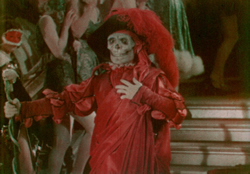 Though not quite as omnipresent as its literary cousins like
Though not quite as omnipresent as its literary cousins like 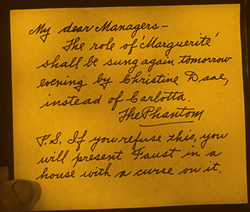 Dracula and Frankenstein, Gaston Leroux's marvelous horror/adventure novel The Phantom of the Opera has proven to be a wonderfully resilient creature for over a century. Inspiring numerous big screen adaptations (including Universal and Hammer), a smash stage production, a miniseries, and even a '70s rock musical. However, the most famous version still remains the wildly entertaining silent version starring Lon Chaney, who famously went through another of his extensive, agonizing makeup rituals to create the chilling, skull-like face of Erik, the titular phantom who lurks in the sewers beneath the Paris Opera House.
Dracula and Frankenstein, Gaston Leroux's marvelous horror/adventure novel The Phantom of the Opera has proven to be a wonderfully resilient creature for over a century. Inspiring numerous big screen adaptations (including Universal and Hammer), a smash stage production, a miniseries, and even a '70s rock musical. However, the most famous version still remains the wildly entertaining silent version starring Lon Chaney, who famously went through another of his extensive, agonizing makeup rituals to create the chilling, skull-like face of Erik, the titular phantom who lurks in the sewers beneath the Paris Opera House.
For the five or so people on the planet who may not know the story already, Erik is a tormented, disfigured soul who blackmails the owners of the Paris Opera House into keeping a box open for him under the name of "The Opera Ghost." The current object of his obsession is Christine (Philbin), an understudy for leading diva Carlotta in the current production of Faust; in fact, he lurks in the shadows and gives her guidance in her dressing room. Meanwhile she is courted by the Vicomte Raoul de Chagny (Kerry), whom she keeps at arm's length for fear of outraging her mysterious benefactor. When the owners refuse to let Christine step in to take over the leading role, the phantom unleashes death and destruction upon the opera house and presents Christine with a chilling ultimatum.
Driven entirely by the force of Chaney's performance, The Phantom of the Opera was an expensive, troubled production going through several iterations over the years (with only two essentially surviving now in their entirety). Director Rupert Julian was taken off of the production after an underwhelming premiere in early 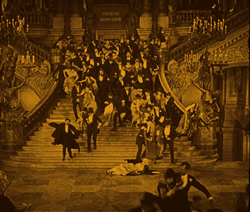 1925, though after a disastrous attempt to lighten up the film, the third version retains much of his footage. The original tragic/romantic ending, now lost, was replaced with a more spectacular crowd-pleasing fate for Erik which, appropriate or not, provides Chaney with one of his wildest, maddest moments on film. As with his incredible turn in The Hunchback of Notre Dame, Chaney is simply incredible here as he delivers a performance that had audiences shrieking in terror at the time. Even now, the famed unmasking scene provokes gasps at theatrical screenings, and his brilliant physicality also pays off during the long passages when he appears with a mask of one kind or
1925, though after a disastrous attempt to lighten up the film, the third version retains much of his footage. The original tragic/romantic ending, now lost, was replaced with a more spectacular crowd-pleasing fate for Erik which, appropriate or not, provides Chaney with one of his wildest, maddest moments on film. As with his incredible turn in The Hunchback of Notre Dame, Chaney is simply incredible here as he delivers a performance that had audiences shrieking in terror at the time. Even now, the famed unmasking scene provokes gasps at theatrical screenings, and his brilliant physicality also pays off during the long passages when he appears with a mask of one kind or 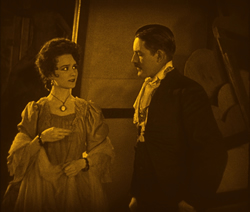 another over his face.
another over his face.
With the advent of sound, a talkie version was prepared complete with reshoots and alternate sequences, not to mention a shorter, reworked silent edition, the one surviving in the best quality today. Surprisingly, one aspect of the film that has also endured is its wonderfully gimmicky use of two-strip Technicolor, utilized in the masquerade ball sequence with Erik crashing in dressed as the Red Death. Hand tinting was also used in the following sequence with a red-caped Erik perched at the top of the opera house, though this touch is lost in most editions.
Thanks to its public domain status, numerous release of Phantom have come and gone over the years including a couple of nice laserdisc editions, countless VHS releases, and a confusing number of DVDs, including two from Image Entertainment -- one from 1997 as part of their David Shepard/Blackhawk line containing the standard 1929 cut, then a two-disc 2003 release from Milestone containing a restored Photoplay transfer from the George Eastman House print of the 1929 version with a terrific score by Carl Davis and a much rougher print of the 1925 version, plus trailers for both, galleries of scenes deleted along the way, a great audio commentary by Scott MacQueen, and dialogue samples from the surviving Vitaphone discs. Unfortunately the transfers (particularly the '29 one) are slathered with an ungodly amount of noise reduction to decimate any shred of film grain or debris, resulting in a very soft, mushy picture with rampant motion blurring.
If you thought things would get simpler with the arrival of Blu-ray, well... nope. Image revisited the title again in 2011 for 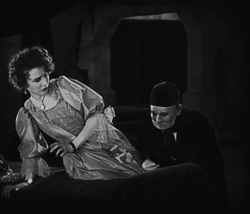 the first HD presentation, back to Blackhawk again with both cuts included. Only the 1929 version is actually HD, in two presentations: 24fps (running 78 minutes) in 1080p with score options from the Alloy Orchestra and Gaylord Carter, and 20fps at 1080i with far less image restoration. The '25 cut is presented only in SD and still looks pretty awful, and other extras include galleries of the screenplay and production and promotional photos, plus a solid commentary by Jon Mirsalis. Unfortunately this release is hampered by a disastrous menu design that makes it almost impossible to determine which version you're watching, much less switch between them (you have to go into the audio options). The lossy
the first HD presentation, back to Blackhawk again with both cuts included. Only the 1929 version is actually HD, in two presentations: 24fps (running 78 minutes) in 1080p with score options from the Alloy Orchestra and Gaylord Carter, and 20fps at 1080i with far less image restoration. The '25 cut is presented only in SD and still looks pretty awful, and other extras include galleries of the screenplay and production and promotional photos, plus a solid commentary by Jon Mirsalis. Unfortunately this release is hampered by a disastrous menu design that makes it almost impossible to determine which version you're watching, much less switch between them (you have to go into the audio options). The lossy 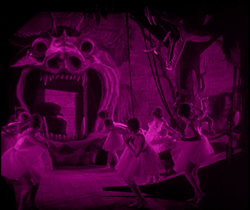 audio isn't the greatest selling point either.
audio isn't the greatest selling point either.
Later in 2001, the UK got its own Blu-ray version with a release from Park Circus, again with the 1929 version (looking very nice and probably the same Blackhawk master), complete with two-strip ball sequence and hand tinted bits and both score options, and an SD version of the '25 one (with the 1990 Gabriel Thibaudeau score as with the Image release). However, the lossless audio makes a big difference; if you like either of those music options, this is definitely better than the American release if the Region B encoding isn't an issue.
Two years later in 2013, the BFI released a dual-format version of their own containing three discs, and it's region free to boot. The Blu-ray is taken from the same excellent print used for the Milestone release but is thankfully free from all that digital smearing; it's now the really striking, lovely presentation it should have been all along and shows off the Photoplay restoration in its best light to date. (Frame grabs seen here are from this version, which should also give you an idea of the color tinting.) The Carl Davis score also sounds tremendous courtesy of PCM stereo and DTS-HD 5.1 audio options, both of which sound great. (The 2.0 one is closer to what purists have heard in theatrical screenings, but either 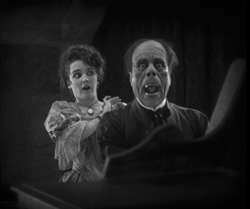 one works just fine.) Presumably because they were sourced from another print, the color scenes are noticeably windowboxed, as are a handful of additional shots. Notably, this is also the only release to date with the 1925 version in HD, taken from Photoplay's 16mm Show-at Home print. For what it's worth, this is the cleanest and most watchable transfer for this variant so far; it's still obviously from inferior film elements but a significant step up from the SD seen on other editions. (For the curious, click here, here and here for frame grabs from this version.) Both trailers are included as well ('25 and '29 sound reissue), but the most interesting inclusion is definitely the surviving fifth reel from the sound release (from the Library of Congress archives) complete with the chandelier sequence and some opera singing making for an effective, fascinating glimpse at how this tweaked talkie once played. Also included is the still perplexing opening sequence featuring a man with a lantern saying something to the audience in the sewers; likely prepared for a sound release at some point, this has often been tacked on to the beginning of the silent transfers and made for a very weird way to open the movie. The same package is carried over to the second disc, a DVD, while a third DVD contains the entire Lon Chaney: A Thousand Faces documentary from Turner Classic Movies, also seen in the TCM Chaney set. It's a great introduction to the pioneering actor with a look at his significant roles in many genres, and you'll probably want to move on to more of his titles after it's over. Finally the release rounds out with a wonderful essay by Photoplay's Kevin Brownlow (a silent film guru if there ever was one), an additional rundown on the film's release history from Photoplay's Patrick Stanbury, and a 1975 review by Geoff Brown. There's always room on any horror collector's shelf for another version of this eccentric, grotesque, and wildly endearing classic, and this one more than deserves a slot of its own.
one works just fine.) Presumably because they were sourced from another print, the color scenes are noticeably windowboxed, as are a handful of additional shots. Notably, this is also the only release to date with the 1925 version in HD, taken from Photoplay's 16mm Show-at Home print. For what it's worth, this is the cleanest and most watchable transfer for this variant so far; it's still obviously from inferior film elements but a significant step up from the SD seen on other editions. (For the curious, click here, here and here for frame grabs from this version.) Both trailers are included as well ('25 and '29 sound reissue), but the most interesting inclusion is definitely the surviving fifth reel from the sound release (from the Library of Congress archives) complete with the chandelier sequence and some opera singing making for an effective, fascinating glimpse at how this tweaked talkie once played. Also included is the still perplexing opening sequence featuring a man with a lantern saying something to the audience in the sewers; likely prepared for a sound release at some point, this has often been tacked on to the beginning of the silent transfers and made for a very weird way to open the movie. The same package is carried over to the second disc, a DVD, while a third DVD contains the entire Lon Chaney: A Thousand Faces documentary from Turner Classic Movies, also seen in the TCM Chaney set. It's a great introduction to the pioneering actor with a look at his significant roles in many genres, and you'll probably want to move on to more of his titles after it's over. Finally the release rounds out with a wonderful essay by Photoplay's Kevin Brownlow (a silent film guru if there ever was one), an additional rundown on the film's release history from Photoplay's Patrick Stanbury, and a 1975 review by Geoff Brown. There's always room on any horror collector's shelf for another version of this eccentric, grotesque, and wildly endearing classic, and this one more than deserves a slot of its own.
Reviewed on November 19, 2013.


 Though not quite as omnipresent as its literary cousins like
Though not quite as omnipresent as its literary cousins like  Dracula and Frankenstein, Gaston Leroux's marvelous horror/adventure novel The Phantom of the Opera has proven to be a wonderfully resilient creature for over a century. Inspiring numerous big screen adaptations (including Universal and Hammer), a smash stage production, a miniseries, and even a '70s rock musical. However, the most famous version still remains the wildly entertaining silent version starring Lon Chaney, who famously went through another of his extensive, agonizing makeup rituals to create the chilling, skull-like face of Erik, the titular phantom who lurks in the sewers beneath the Paris Opera House.
Dracula and Frankenstein, Gaston Leroux's marvelous horror/adventure novel The Phantom of the Opera has proven to be a wonderfully resilient creature for over a century. Inspiring numerous big screen adaptations (including Universal and Hammer), a smash stage production, a miniseries, and even a '70s rock musical. However, the most famous version still remains the wildly entertaining silent version starring Lon Chaney, who famously went through another of his extensive, agonizing makeup rituals to create the chilling, skull-like face of Erik, the titular phantom who lurks in the sewers beneath the Paris Opera House.  1925, though after a disastrous attempt to lighten up the film, the third version retains much of his footage. The original tragic/romantic ending, now lost, was replaced with a more spectacular crowd-pleasing fate for Erik which, appropriate or not, provides Chaney with one of his wildest, maddest moments on film. As with his incredible turn in The Hunchback of Notre Dame, Chaney is simply incredible here as he delivers a performance that had audiences shrieking in terror at the time. Even now, the famed unmasking scene provokes gasps at theatrical screenings, and his brilliant physicality also pays off during the long passages when he appears with a mask of one kind or
1925, though after a disastrous attempt to lighten up the film, the third version retains much of his footage. The original tragic/romantic ending, now lost, was replaced with a more spectacular crowd-pleasing fate for Erik which, appropriate or not, provides Chaney with one of his wildest, maddest moments on film. As with his incredible turn in The Hunchback of Notre Dame, Chaney is simply incredible here as he delivers a performance that had audiences shrieking in terror at the time. Even now, the famed unmasking scene provokes gasps at theatrical screenings, and his brilliant physicality also pays off during the long passages when he appears with a mask of one kind or  another over his face.
another over his face.  the first HD presentation, back to Blackhawk again with both cuts included. Only the 1929 version is actually HD, in two presentations: 24fps (running 78 minutes) in 1080p with score options from the Alloy Orchestra and Gaylord Carter, and 20fps at 1080i with far less image restoration. The '25 cut is presented only in SD and still looks pretty awful, and other extras include galleries of the screenplay and production and promotional photos, plus a solid commentary by Jon Mirsalis. Unfortunately this release is hampered by a disastrous menu design that makes it almost impossible to determine which version you're watching, much less switch between them (you have to go into the audio options). The lossy
the first HD presentation, back to Blackhawk again with both cuts included. Only the 1929 version is actually HD, in two presentations: 24fps (running 78 minutes) in 1080p with score options from the Alloy Orchestra and Gaylord Carter, and 20fps at 1080i with far less image restoration. The '25 cut is presented only in SD and still looks pretty awful, and other extras include galleries of the screenplay and production and promotional photos, plus a solid commentary by Jon Mirsalis. Unfortunately this release is hampered by a disastrous menu design that makes it almost impossible to determine which version you're watching, much less switch between them (you have to go into the audio options). The lossy  audio isn't the greatest selling point either.
audio isn't the greatest selling point either.  one works just fine.) Presumably because they were sourced from another print, the color scenes are noticeably windowboxed, as are a handful of additional shots. Notably, this is also the only release to date with the 1925 version in HD, taken from Photoplay's 16mm Show-at Home print. For what it's worth, this is the cleanest and most watchable transfer for this variant so far; it's still obviously from inferior film elements but a significant step up from the SD seen on other editions. (For the curious, click here, here and here for frame grabs from this version.) Both trailers are included as well ('25 and '29 sound reissue), but the most interesting inclusion is definitely the surviving fifth reel from the sound release (from the Library of Congress archives) complete with the chandelier sequence and some opera singing making for an effective, fascinating glimpse at how this tweaked talkie once played. Also included is the still perplexing opening sequence featuring a man with a lantern saying something to the audience in the sewers; likely prepared for a sound release at some point, this has often been tacked on to the beginning of the silent transfers and made for a very weird way to open the movie. The same package is carried over to the second disc, a DVD, while a third DVD contains the entire Lon Chaney: A Thousand Faces documentary from Turner Classic Movies, also seen in the TCM Chaney set. It's a great introduction to the pioneering actor with a look at his significant roles in many genres, and you'll probably want to move on to more of his titles after it's over. Finally the release rounds out with a wonderful essay by Photoplay's Kevin Brownlow (a silent film guru if there ever was one), an additional rundown on the film's release history from Photoplay's Patrick Stanbury, and a 1975 review by Geoff Brown. There's always room on any horror collector's shelf for another version of this eccentric, grotesque, and wildly endearing classic, and this one more than deserves a slot of its own.
one works just fine.) Presumably because they were sourced from another print, the color scenes are noticeably windowboxed, as are a handful of additional shots. Notably, this is also the only release to date with the 1925 version in HD, taken from Photoplay's 16mm Show-at Home print. For what it's worth, this is the cleanest and most watchable transfer for this variant so far; it's still obviously from inferior film elements but a significant step up from the SD seen on other editions. (For the curious, click here, here and here for frame grabs from this version.) Both trailers are included as well ('25 and '29 sound reissue), but the most interesting inclusion is definitely the surviving fifth reel from the sound release (from the Library of Congress archives) complete with the chandelier sequence and some opera singing making for an effective, fascinating glimpse at how this tweaked talkie once played. Also included is the still perplexing opening sequence featuring a man with a lantern saying something to the audience in the sewers; likely prepared for a sound release at some point, this has often been tacked on to the beginning of the silent transfers and made for a very weird way to open the movie. The same package is carried over to the second disc, a DVD, while a third DVD contains the entire Lon Chaney: A Thousand Faces documentary from Turner Classic Movies, also seen in the TCM Chaney set. It's a great introduction to the pioneering actor with a look at his significant roles in many genres, and you'll probably want to move on to more of his titles after it's over. Finally the release rounds out with a wonderful essay by Photoplay's Kevin Brownlow (a silent film guru if there ever was one), an additional rundown on the film's release history from Photoplay's Patrick Stanbury, and a 1975 review by Geoff Brown. There's always room on any horror collector's shelf for another version of this eccentric, grotesque, and wildly endearing classic, and this one more than deserves a slot of its own.